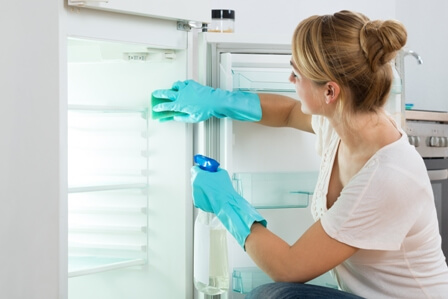The fridge is the undisputed workhorse of the kitchen, helping you to keep large amounts of food fresh and making sure spoilt food doesn’t foul your kitchen. Your refrigerator may also be the highest power consumption, especially when it is not performing optimally. It is important to carry out routine maintenance of your refrigerator to extend its life expectancy, reduce your energy bills, and get more out of your investment. Here are how you maintain the fridge in 6 easy steps.
Deodorize
It’s important that you maintain the fridge free of any foul odors by deodorizing it. One way of doing this is to cover foods stored in the refrigerator to prevent the spread of odor throughout the appliance. You can also place an open box of baking soda, a bowl or coffee ground or activated charcoal in the fridge to absorb any unwanted odors. However, the most effective way of deodorizing your fridge is to use a deodorizer made specifically for refrigerators. These types of deodorizers can last up to six months and will ensure that your appliance remains fresh and odor-free.
To prevent odors from migrating throughout the refrigerator, make sure to store foods in airtight containers to lock in the odors and keep them fresh for an extended period. If you want to store items that may leak some fluid such as meat, fish, or fruits, be sure to place them in a prevent any spills.
Keep the Interior Clean
 Every week, use a damp cloth to remove crumbs and spills and wipe down the walls and shelves. Make sure to remove any sticky spills and stubborn stains or greasy spots. Don’t forget to wipe down the handles and doors.
Every week, use a damp cloth to remove crumbs and spills and wipe down the walls and shelves. Make sure to remove any sticky spills and stubborn stains or greasy spots. Don’t forget to wipe down the handles and doors.
Replace the Water Filter
To prevent leaks and clogs and to ensure the water and ice from the fridge are clean, replace the water filter every six months. Your owner’s manual should provide instructions on the location and procedures for replacing the filter. To remove any carbon residues from the new filter, run a few gallons of water through it.
Clean the Condenser Coils
Every six months, it’s important to clean the condenser coils on your refrigerator. They are found beneath or at the back of your appliance and are responsible for removing heat from the refrigerator. The condenser coils can’t work effectively if they are dirty or dusty and this can increase their energy consumption. Your owner’s manuals will give you the steps you should take to clean the condenser coils, but you can also use a long-handled bristle brush and a vacuum to remove any dirt or dust clinging to the condenser coils.
Defrost
When you notice that your refrigerator has accumulated up to one centimeter of frost in its interior, it’s time to defrost. Remove food from the unit and either unplug it or switch off the thermostat. Wait until the frost has melted completely before turning the refrigerator back on. Then wait for it to reach its operating temperature before restocking it with food. If you are using a self-defrosting appliance, you don’t need to do any manual defrosting as the unit will heat up its cooling coils every 6-8 hours to melt any accumulating frost.
Inspect the Gaskets
Gaskets are the rubber seal found on the edges of your refrigerator or freezer doors, and they help to seal out warm air. It is important to clean your gaskets regularly as dirt and grime may prevent them from sealing the unit properly, and this reduces the efficiency of the appliance and increases energy consumption. If you find that the gaskets are worn out, lose, or torn, it’s better to replace them to reduce stress on your unit and your purse.
